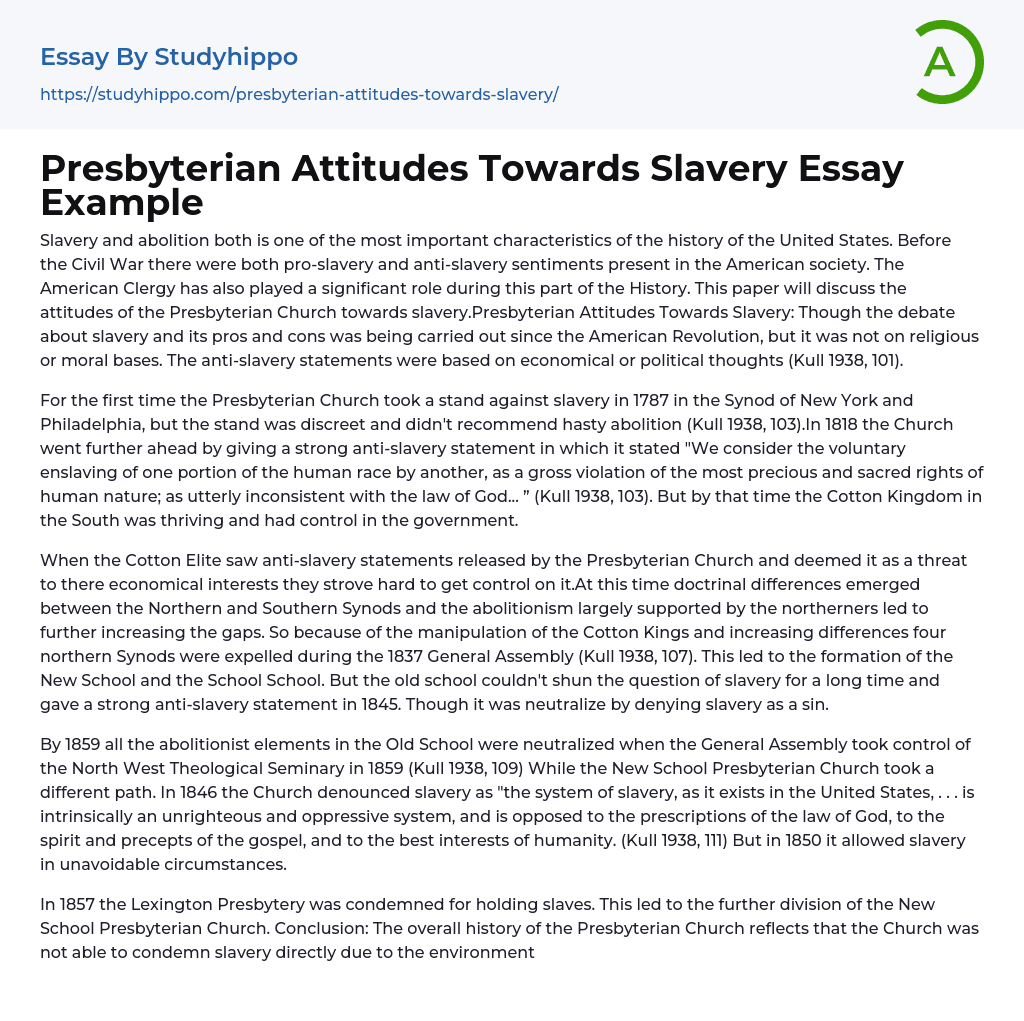Slavery and abolition both is one of the most important characteristics of the history of the United States. Before the Civil War there were both pro-slavery and anti-slavery sentiments present in the American society. The American Clergy has also played a significant role during this part of the History. This paper will discuss the attitudes of the Presbyterian Church towards slavery.Presbyterian Attitudes Towards Slavery: Though the debate about slavery and its pros and cons was being carried out since the American Revolution, but it was not on religious or moral bases. The anti-slavery statements were based on economical or political thoughts (Kull 1938, 101).
For the first time the Presbyterian Church took a stand against slavery in 1787 in the Synod of New York and Philadelphia, but the stand was discreet and didn't recommend hasty
...abolition (Kull 1938, 103).In 1818 the Church went further ahead by giving a strong anti-slavery statement in which it stated "We consider the voluntary enslaving of one portion of the human race by another, as a gross violation of the most precious and sacred rights of human nature; as utterly inconsistent with the law of God... ” (Kull 1938, 103). But by that time the Cotton Kingdom in the South was thriving and had control in the government.
When the Cotton Elite saw anti-slavery statements released by the Presbyterian Church and deemed it as a threat to there economical interests they strove hard to get control on it.At this time doctrinal differences emerged between the Northern and Southern Synods and the abolitionism largely supported by the northerners led to further increasing the gaps. So because of the manipulation of the Cotton
Kings and increasing differences four northern Synods were expelled during the 1837 General Assembly (Kull 1938, 107). This led to the formation of the New School and the School School. But the old school couldn't shun the question of slavery for a long time and gave a strong anti-slavery statement in 1845. Though it was neutralize by denying slavery as a sin.
By 1859 all the abolitionist elements in the Old School were neutralized when the General Assembly took control of the North West Theological Seminary in 1859 (Kull 1938, 109) While the New School Presbyterian Church took a different path. In 1846 the Church denounced slavery as "the system of slavery, as it exists in the United States, . . . is intrinsically an unrighteous and oppressive system, and is opposed to the prescriptions of the law of God, to the spirit and precepts of the gospel, and to the best interests of humanity. (Kull 1938, 111) But in 1850 it allowed slavery in unavoidable circumstances.
In 1857 the Lexington Presbytery was condemned for holding slaves. This led to the further division of the New School Presbyterian Church. Conclusion: The overall history of the Presbyterian Church reflects that the Church was not able to condemn slavery directly due to the environment and society. It is hard for the clergy to impose anything on moral bases disregarding the interests of the social and industrial elite.
- Baptism essays
- Holy Spirit essays
- Jesus Christ essays
- Adam And Eve essays
- Crucifixion Of Jesus essays
- Crusades essays
- Eucharist essays
- God The Father essays
- Pope essays
- Protestantism essays
- Christian essays
- Church essays
- Elizabeth essays
- Sacrament essays
- Catholic Church essays
- Lord essays
- Priest essays
- Protestant Reformation essays
- Slave Trade essays
- Attitude essays
- Goals essays
- Personal Goals essays
- Personal Life essays
- Personality essays
- Principles essays
- Reputation essays
- Self Awareness essays
- Self Esteem essays
- Self Reflection essays
- Self Reliance essays
- Strengths essays
- Value essays
- Values essays
- Weakness essays
- Who Am I essays
- Afterlife essays
- Atheism essays
- Bible essays
- Buddhism essays
- Christian Worldview essays
- Christianity essays
- Confession essays
- Cosmological Argument essays
- Deism essays
- Devil essays
- Existence of God essays
- Faith essays
- Freedom Of Religion essays
- God essays
- Hinduism essays




